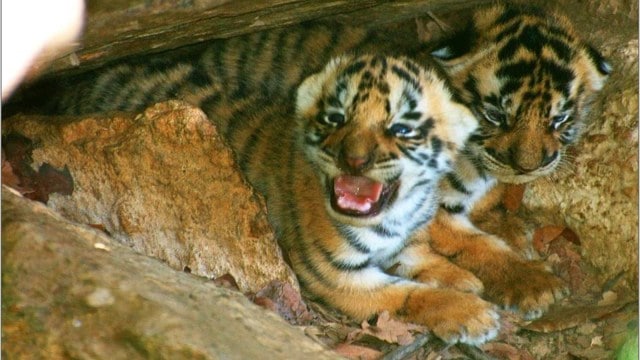‘Graduation’ after 60 kills: Rewilding rescued tigers at MP ‘school’
A tiger is rewilded after spending around two-and-a-half years in the enclosure. It is then monitored with the help of a radio collar for another year. Once it is accustomed to its new setting, the collar is removed.
 Two orphaned cubs at the Kanha Tiger Reserve. (Express Photo)
Two orphaned cubs at the Kanha Tiger Reserve. (Express Photo)The curriculum at this academy is brutal — hunting prowess, kill count and the ability to evade human detection.
The students are orphaned tigers who have been rescued and are being trained at the Kanha Tiger Reserve in Madhya Pradesh to be released into the wild again.
Since its inception in 2005, the Kanha Tiger Reserve has successfully rewilded a dozen tigers, setting a benchmark. Before this, orphaned tigers would typically end up in zoos.
Currently undergoing training there is a batch of four tigers rescued from Seoni and Bhopal districts. All four were found under similar circumstances — waiting for their mothers near lakes. In all cases, they were surrounded by village residents who were teasing them. In one case, the villagers threw stones.
The four tigers include two siblings — both four months old — from Bhopal. Their mother died fighting a male tiger in the jungles of Ratapani. The two others are unrelated, but are from Seoni. One is now two-and-a-half years old and the other 20 months. Their mothers did not turn up as they waited at the lake.
Wildlife officials rescued the tigers by luring them into a cage using a goat as bait.
At the reserve, the younger three tigers share a 2,000-square-foot predator-proof enclosure. The older one has been moved into a larger enclosure. They now spend their days lazing around and hunting small animals.
Wildlife officials watch from a distance, noting each kill. Once a tiger racks up a kill count of 60 chitals (spotted deer) it can “graduate” and be released into the wild.
“The two senior-most tigers are showing positive signals, and they are able to avoid humans. All the cubs are now able to hunt chickens on their own. They are slowly moving to goats. The cubs are doing well — they are able to kill in 20 seconds,” Kanha National Park Field Director S K Singh told The Indian Express.
The first tiger rewilding project at the reserve began in 2005. Officials first built a large in-situ enclosure in the tiger reserve. The enclosure holds a small number of chital that can be driven into an inner enclosure for predation by tigers. CCTV cameras were also installed to record activities and minimise human imprinting on the tigers.
Kanha vetenarian Dr Sandeep Aggarwal knows each tiger that graduated from the enclosure. “Most of the rewilded tigers are still alive. There was a case of two tigers, however, who did not make it – one died in a fight with other tigers and the other one went missing,” he said.
It is essential none of the tigers get accustomed to human touch.
From the time the cubs are 20-22 days old, they are fed milk, eggs, and mashed meat by park officials for two months. At the age of three-four months, live predation begins in the enclosures.
“The cubs first learn to hunt chickens. At around six-eight months, they begin hunting goats, and in 15 months, they are moved to a larger enclosure where they hunt chitals. There are times when the tiger is unable to hunt properly and we intervene, putting it back to hunting goats till it develops its own hunting skills,” Aggarwal said.
A tiger is rewilded after spending around two-and-a-half years in the enclosure. It is then monitored with the help of a radio collar for another year. Once it is accustomed to its new setting, the collar is removed.
According to Aggarwal, young cubs have the highest chance of being rewilded.
The National Tiger Conservation Authority (NTCA) now heavily relies on Kanha’s rewilding expertise while developing its standard operating procedures for tiger rewilding, according to Field Director Singh.







